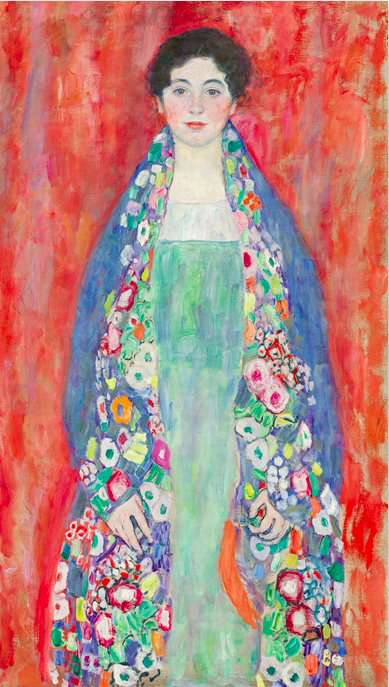Gustav Klimt: Portrait of Miss Lieser
[12/04/2024]A magnificent rediscovery
On 24 April, Vienna’s Kinsky auction house will be offering a rediscovered painting by Gustav Klimt, Portrait of Miss Lieser (1917). Kept secretly by some private Austrian owners, the painting was thought to have been lost for almost a century. The rediscovery of this large female portrait, one of Klimt’s best portraits from his latter creative period, has of course excited the art world.
A key figure in Viennese Art Nouveau, Gustav KLIMT was the main driver of Austrian Modernism at the end of the 19th century. His works – particularly his portraits of Viennese high society women from the early 20th century – enjoy extraordinary global popularity, and his paintings are regularly sold on the international art market. However, his portraits of women are extremely rare at auction. Indeed, in terms of rarity, artistic quality and value, the art market in Central Europe has been unable to offer a comparable Klimt work for decades, and this is particularly true in Austria, where no work of this importance has ever been offered.
The painting will be auctioned on behalf of the current owners (private Austrian property) and the legal successors of Adolf and Henriette Lieser (on the basis of an agreement in accordance with the Washington Principles of 1998) on 24 April 2024 at the Kinsky auction house in Vienna.
From black and white to bright colors
The painting is documented in catalogs of Gustav Klimt’s paintings, but it was only known to experts via a black and white photo. The vivid colors of the portrait are now visible for the first time, showing the coloristic intensity that characterized Klimt’s palette in his latter years.
Klimt’s model: which Miss Lieser?
In the first catalogue raisonné of Klimt’s paintings by Fritz Novotny and Johannes Dobai, published in 1967, the model for this painting is called “Fräulein Lieser”. The authors of the most recent catalogue raisonné (Weidinger 2007 and Natter 2012) identified the subject as Margarethe Constance Lieser (1899-1965), daughter of the industrialist Adolf Lieser. However, new research on the painting’s history and provenance by the Kinsky auction house suggests that Klimt’s model could have been another member of the Lieser family: either Hélène Lieser (1898-1962), the firstborn of Henriette Amalie Lieser-Landau and Justus Lieser, or her youngest daughter, Annie Lieser (1901-1972).

Gustav Klimt, Bildnis Fräulein Lieser (1917)
Klimt’s client
The Lieser family belonged to Vienna’s wealthy bourgeoisie, where Klimt found his patrons and clients. The brothers Adolf and Justus Lieser were among the leading industrialists of the Austro-Hungarian Empire. Henriette Amalie Lieser-Landau, known as “Lilly”, was married to Justus Lieser until 1905 and was a patron of artistic avant-garde circles. In the catalogs of Klimt’s paintings, it is said that Adolf Lieser commissioned Gustav Klimt to paint a portrait of his eighteen-year-old daughter Margarethe Constance. However, some evidence suggests that art enthusiast Lilly Lieser commissioned Klimt to immortalize one of her two daughters on canvas.
An exceptional portrait from Klimt’s latter creative period
In April and May 1917, the model visited Klimt’s Hietzinger studio nine times to pose for him. At least 25 preliminary studies were made. Klimt probably began painting in May 1917. The painter chose to work on a three-quarter portrait and depicts the young woman in a strict frontal pose, close to the foreground of the painting, a format he had already tried in his Portrait of Adèle Bloch-Bauer II, completed in 1912.
The woman is positioned in the center of the painting in front of an undefined red background. A mantle richly decorated with flowers is draped around her shoulders. While Klimt paints the face of Fräulein Lieser in a sensitive and naturalistic manner, with precise lines, other parts of the painting reflect the pictorial freedom of his late style. Powerful complementary tones determine the masterful orchestration of colors. The coloristic intensity of the image and the shift to a free and open brushwork style shows Klimt at the very peak of his artistic development.
Indeed, the rediscovery of this Portrait of Miss Lieser adds another fascinating dimension to our perception of the last creative phase of Austria’s Art Nouveau icon. At the end of his life, Klimt was clearly looking to the future and adopting a more Modern approach with astonishing gestural freedom and a highly expressive use of color.
One of Klimt’s very last works
The painter’s death on 6 February 1918 following a stroke brought an abrupt end to the finalization of the painting. The canvas was still unfinished in some small sections, and the client collected the painting from Klimt’s studio.
The fate of the painting after 1925
The only known photo of the painting is kept in the archives of the Austrian National Library. It was probably taken in 1925 as part of the exhibition Klimt curated by Otto Kallir-Nirenstein at the Neue Galerie in Vienna. On the inventory sheet of this negative appears the mention: “1925 in possession of Mme Lieser, IV, Argentinierstrasse 20”. The exact fate of the painting after 1925 is unclear. What is certain is that it was acquired by a legal predecessor of the consignee in the 1960s and that it was inherited by the current owner through three successions.
Information on the Gustav Klimt sale:
Im Kinsky Auction House (Vienna, Austria)
Auction on 24 April 2024
Visit: 13 – 21 April, 10 a.m. to 5 p.m.
Gustav Klimt
Portrait of Miss Lieser (Bildnis Fräulein Lieser), 1917
Estimation: €30,000,000 – $50,000,000




 0
0
